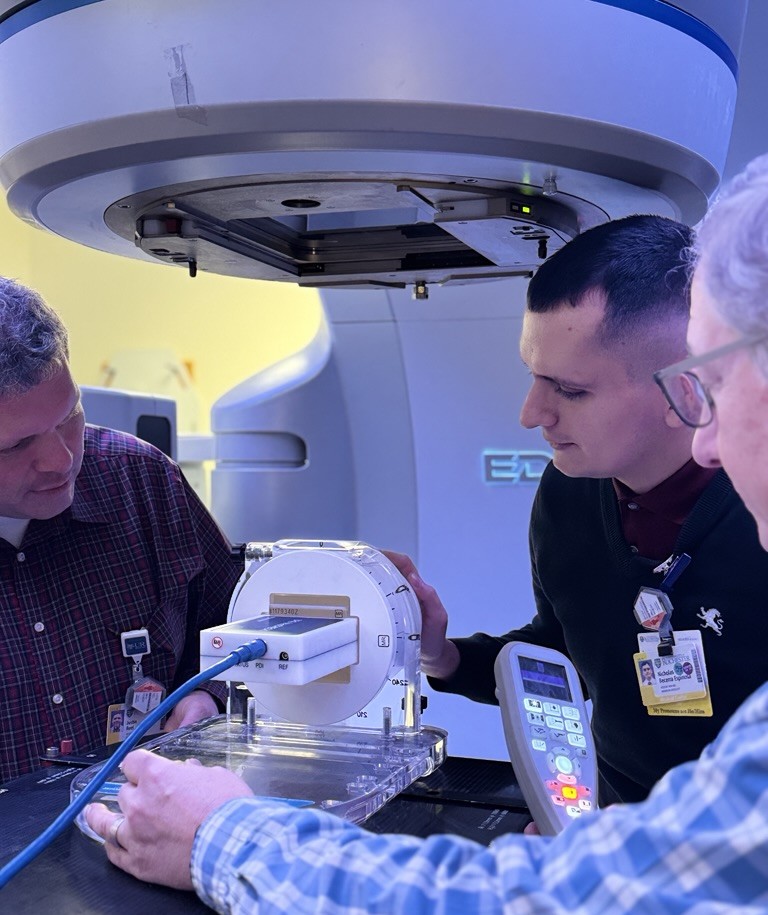Comprehensive Clinical Curriculum: Mastering Modern Medical Physics
Comprehensive Clinical Curriculum: Mastering Modern Medical Physics
The Therapeutic Medical Physics Residency Program at the University of Rochester Medical Center (URMC), an NCI-designated Cancer Center, offers a rigorous, structured curriculum designed to develop the clinical expertise required for independent practice in radiation oncology physics.
Our two-year curriculum provides broad exposure to modern radiation therapy technologies and techniques while ensuring mastery of core competencies aligned with CAMPEP and AAPM guidelines. Residents progress through eight structured three-month clinical rotations, each designed to build confidence, deepen knowledge, and refine technical skills under the guidance of experienced faculty mentors.
Clinical Rotations: Core Training Experiences
Residents immerse themselves in comprehensive clinical rotations, comprising the majority of their training, under the direct supervision of dedicated faculty mentors. These mentors provide continuous performance evaluation and guidance to ensure all training objectives are met. Our eight, three-month rotations provide in-depth exposure to critical areas within medical physics, including:
- Precision Patient Delivery: Advanced patient setup, positioning, and immobilization techniques.
- Cutting-Edge Imaging: Mastery of 2D, 3D, and 4D imaging modalities.
- Advanced Treatment Planning: In-depth experience in sophisticated treatment planning systems and methodologies.
- Linear Accelerator Management: Hands-on training in quality assurance, acceptance testing, and comprehensive commissioning of linear accelerators.
- Adaptive Radiation Therapy (ART): Expertise in the evolving field of adaptive radiation therapy.
- Specialized Procedures: Extensive training in advanced techniques such as stereotactic body radiation therapy (SBRT), Linac-based stereotactic radiosurgery (SRS), and Gammaknife SRS.
- Total Body Irradiation (TBI): Clinical experience in total body irradiation.
- Brachytherapy Excellence: Proficiency in high-dose rate (HDR) brachytherapy procedures, eye plaques, and liver ablation.
- Radiation Safety & Protection: Comprehensive understanding and application of radiation safety principles and patient/personnel protection.
- Dosimetry & Detection: Skills in radiation detection and in-vivo dosimetry.
- RT Informatics: Proficiency in radiation therapy informatics.
- Professional Conduct: Emphasis on ethics and professionalism in clinical practice.
- Proton Therapy: Introduction to the principles and practice of proton therapy.
Educational Activities & Professional Development
Residents are deeply engaged in educational opportunities and departmental conferences to strengthen clinical reasoning and analytical skills.
Regular Departmental Conferences
- Journal Club – review of current literature and emerging technologies
- New Patient / Chart Rounds – multidisciplinary case review and treatment discussions
- Physics & Dosimetry Meetings – technical problem-solving and project updates
- Morbidity & Mortality Conference – quality improvement and outcome analysis
- Visiting Speaker Series – presentations from national and international experts
- Research Meetings – ongoing project development, feedback, and collaboration
Residents give at least two formal presentations per year and are strongly encouraged to attend scientific meetings. Each resident receives funding to attend one national and one regional professional conference, with additional support available when presenting accepted abstracts.
Evaluation and Competency Assessment
To ensure continual growth and readiness for professional practice, the program incorporates a comprehensive evaluation system:
- Rotation-specific goals and competencies assessed by faculty mentors
- Monthly oral exams modeled after the ABR Part 3 examination
- End-of-rotation written reports for most clinical blocks
- Regular feedback from physicists, physicians, dosimetrists, and therapists
This robust process ensures that residents receive consistent, structured guidance throughout their residency and are well prepared for ABR board certification.
